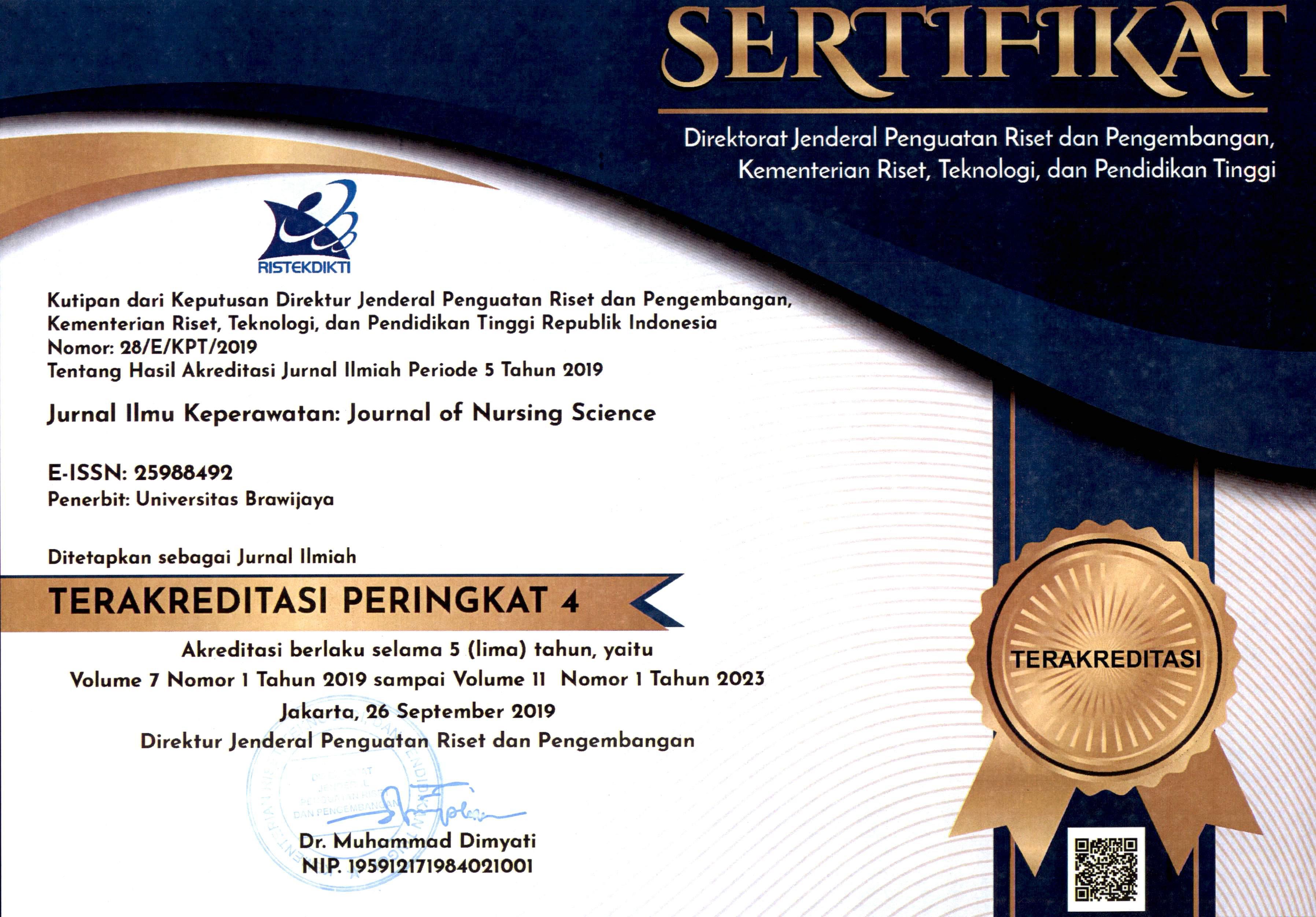POLICE OFFICER’S EXPECATTIONS AS A FIRST RESPONDER IN ROAD TRAFFIC ACCIDENTS: A QUALITATIVE STUDY
DOI:
https://doi.org/10.21776/ub.jik.2019.007.01.6Keywords:
first responder, expectation, traffic accidentAbstract
Police officers are first responder with special lay category. Police have an additional duty to provide first aid to victims of accidents because medical personnel are still limited to provide help. Certainly the police have their own experience that needs to be explored to find out what expectations are for their daily activities in helping victims of current traffic accidents. This study used a qualitative design of hermeneutic phenomenology to explore and interpret police officers' expectations as first responder in traffic accident victims. The number of participants as many as 5 people who served at the Post Purwodadi Lands Area Pasuruan Police. Instruments in this study that researchers as a core instrument and other supporting tools that is in the form of a netbook equipped with a camtasia studio voice recorder program, ballpoint pen, and paper for field notes. Data collected through indepth interview processed into tranksrip and then analyzed by using method Dikelmann et al (1989). The results of the research are two cross-sectoral cooperation and the need for an award. The theme of cross-sector cooperation is built on two sub themes, namely cooperation with hospitals and cooperation with the community. The theme of need for an award is built by a sub theme that needs rewards. The conclusion of this research is that police officers have big expectation to the related parties to give the best first aid for the safety of traffic accident victims. Thus, it is hoped that the cooperation will be strengthened to support police officers in helping victims of traffic accidents to reduce the mortality and morbidity of traffic accident victims.
References
- Goonewardene, S. Khalid, B., Keith, P., and Sargeant, I. (2010). Road traffic collisions-case fatality rate, crash injury rate, and number of motor vehicles: time trends between a developed and developing coountry. The American Surgeon. 76(9): 977-981.
- Pusponegoro, A.D. (2011). The Silent Disaster: Bencana dan Korban Massal. Sagung Seto: Jakarta.
- Geduld, H. and Wallis, L. (2011). Taxi driver training in Madagascar: the first step in developing a functioning prehospital emergency care system. Emergency Medicine Journal of Prehospital Care, 28: 794-796.
- Departemen Perhubungan, 2010. Kecelakaan Jalan Raya di Indonesia Terjadi Setiap 9,1 Menit. (Online). (http://www.dephub.go.id/read/berita/direktorat-jenderal-perhu bungan-darat /2307), Diakses Senin, 1 April 2013 pukul 10:08 WIB.
- Elmqvist, C., Brunt, D., Fridlund, B., and Ekebergh, M. (2010). Being first on the scene of an accident-experiances of „doing‟ prehospital emergency care. Journal Compilation Nordic of Caring Science, 24: 266-273.
- World Health Organization. (2005). Prehospital trauma care system. Jenewa.
- Jayaraman, S., Mabweijano, J.R., Lipnick, M.S., Caldwell, N., Miyamoto, J., Wangoda, R. et al. (2009). Current patterns of prehospital trauma care in Kampala, Uganda and the feasibility of a lay-first-responder training program. World Journal of Surgery, 33: 2512–2521.
Downloads
Published
How to Cite
License
Authors published in this journal agree to the following terms:
1. The copyright of the received article shall be assigned to the journal as the publisher of the journal. The intended copyright includes the right to publish the article in various forms (including reprints). The journal maintains the publishing rights to the published articles.
2. Authors may enter into separate additional contractual agreements for the non-exclusive distribution of the published journal version of the work (for example, posting it to an institutional repository or publishing it in a book), with acknowledgment of their initial publication in this journal.
3. Authors are permitted and encouraged to post their work online (e.g. in an Institutional Repository or on their website) before and during the submission process, as this can result in a productive exchange, as well as earlier and larger citations of the published work.
4. Articles and all related material published are distributed under Creative Commons Attribution-NonCommercial 4.0 International License or CC BY-NC 4.0 license.
JNSU is licensed under a Creative Commons Attribution-NonCommercial 4.0 International License or CC BY-NC 4.0 license.
Most read articles by the same author(s)
- Bintari Ratih Kusumaningrum, Indah Winarni, Setyoadi Setyoadi, Kumboyono Kumboyono, Retty Ratnawati, PENGALAMAN PERAWAT UNIT GAWAT DARURAT (UGD) PUSKESMAS DALAM MERAWAT KORBAN KECELAKAAN LALU LINTAS , Journal of Nursing Science Update (JNSU): Vol. 1 No. 2 (2013)
- Maria Imaculata Ose, Retty Ratnawati, Retno Lestari, STUDI FENOMENOLOGI PENGALAMAN PERAWAT INSTALASI GAWAT DARURAT (IGD) DALAM MERAWAT PASIEN TERLANTAR PADA FASE END OF LIFE DI RSUD Dr. SAIFUL ANWAR MALANG , Journal of Nursing Science Update (JNSU): Vol. 4 No. 2 (2016)
- Ika Setyo Rini, Dini Widya Ayuningtyas, Retty Ratnawati, FAKTOR-FAKTOR YANG BERHUBUNGAN DENGAN PERSEPSI GEJALA NYERI DADA KARDIAKISKEMIK PADA PASIEN INFARK MIOKARD AKUT DI RSUD dr. SAIFUL ANWAR MALANG , Journal of Nursing Science Update (JNSU): Vol. 5 No. 1 (2017)
- Iva Milia Hani Rahmawati, Retty Ratnawati, Septi Dewi Rachmawati, PENGALAMAN PERAWAT DALAM MEMBERIKAN LAYANAN KEPERAWATAN JIWA PADA PECANDU NAPZA DI PUSAT REHABILITASI BADAN NARKOTIKA NASIONAL KARESIDENAN KEDIRI , Journal of Nursing Science Update (JNSU): Vol. 4 No. 2 (2016)
- Yati Nur Azizah, Retty Ratnawati, Setyoadi Setyoadi, PENGALAMAN PERAWAT DALAM MELAKUKAN PENILAIAN CEPAT KESEHATAN KEJADIAN BENCANA PADA TANGGAP DARURAT BENCANA ERUPSI GUNUNG KELUD TAHUN 2014 DI KABUPATEN MALANG (STUDI FENOMENOLOGI) , Journal of Nursing Science Update (JNSU): Vol. 3 No. 2 (2015)
- Fransiska Erna Damayanti, Retty Ratnawati, Fransiska Imavike Fevriasanty, PENGALAMAN ISTRI TENTARA (TNI-AD) YANG TINGGAL DI BATALYON SAAT SUAMI BERTUGAS DI DAERAH RAWAN KONFLIK , Journal of Nursing Science Update (JNSU): Vol. 4 No. 2 (2016)
- Sutono Sutono, Retty Ratnawati, Tony Suharsono, PERBEDAAN NILAI KOMPRESI DADA DAN VENTILASI PADA PELATIHAN RESUSITASI JANTUNG PARU MAHASISWA S1 KEPERAWATAN DENGAN UMPAN BALIK INSTRUKTUR, AUDIOVISUAL DAN KOMBINASI DI YOGYAKARTA , Journal of Nursing Science Update (JNSU): Vol. 3 No. 2 (2015)
- Ikhda Ulya, PENGARUH PEMBERIAN GEL EKSTRAK DAUN MELATI (Jasminum sambac L. Ait) TERHADAP JUMLAH FIBROBLAS KULIT DALAM PENYEMBUHAN LUKA BAKAR DERAJAT II A PADA TIKUS PUTIH (Rattus norvegicus) GALUR WISTAR , Journal of Nursing Science Update (JNSU): Vol. 4 No. 1 (2016)
- Merry Januar Firstiana, Retty Ratnawati, Retno Lestari, FENOMENOLOGI : PENGALAMAN CARING PERAWAT PADA PASIEN TRAUMA DENGAN KONDISI KRITIS (P1) DI IGD RSUD TARAKAN-KALIMANTAN UTARA , Journal of Nursing Science Update (JNSU): Vol. 5 No. 1 (2017)
- Rita Rinjani Mekka, Retty Ratnawati, Septi Dewi Rachmawati, STUDI FENOMENOLOGI : PENGALAMAN PERAWAT TERKAIT KETIDAKBERHASILAN RESUSITASI PADA NEONATAL DENGAN ASFIKSIA DI RUANG NEONATUS RSUD DR. R. SOEDJONO SELONG LOMBOK TIMUR , Journal of Nursing Science Update (JNSU): Vol. 4 No. 2 (2016)





























